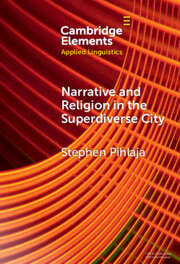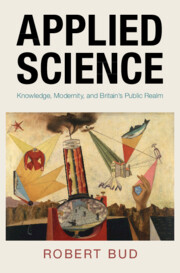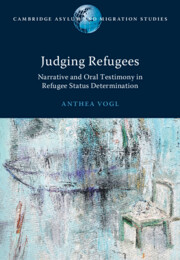336 results
6 - Performances of Suffering
-
- Book:
- Constructing Religious Martyrdom
- Print publication:
- 27 June 2024, pp 323-361
-
- Chapter
- Export citation
4 - Poem/Novel
- from Part I - Ideas of the Poem
-
-
- Book:
- The Cambridge Companion to the Poem
- Published online:
- 30 May 2024
- Print publication:
- 06 June 2024, pp 67-82
-
- Chapter
- Export citation
Chapter 14 - Railway Imaginary in the 1830s
-
-
- Book:
- Nineteenth-Century Literature in Transition: The 1830s
- Published online:
- 30 May 2024
- Print publication:
- 06 June 2024, pp 304-318
-
- Chapter
- Export citation
“Spectator to One's Own Life”
-
- Journal:
- Journal of the American Philosophical Association , First View
- Published online by Cambridge University Press:
- 20 May 2024, pp. 1-20
-
- Article
-
- You have access
- HTML
- Export citation
Chapter 6 - 1926: Traditions Old and New
- from Part I - Literary Dates
-
-
- Book:
- A History of Argentine Literature
- Published online:
- 09 May 2024
- Print publication:
- 16 May 2024, pp 81-96
-
- Chapter
- Export citation
Narrative drives design decision-making
-
- Journal:
- Proceedings of the Design Society / Volume 4 / May 2024
- Published online by Cambridge University Press:
- 16 May 2024, pp. 965-974
-
- Article
-
- You have access
- Open access
- Export citation
Chapter 10 - 2001: Argentine Narrative in the New Millennium
- from Part I - Literary Dates
-
-
- Book:
- A History of Argentine Literature
- Published online:
- 09 May 2024
- Print publication:
- 16 May 2024, pp 147-162
-
- Chapter
- Export citation
Chapter 1 - Introduction
-
- Book:
- The Theology of the Book of Samuel
- Published online:
- 08 May 2024
- Print publication:
- 09 May 2024, pp 1-13
-
- Chapter
- Export citation
19 - Community Arts, Decoloniality, and Epistemic Justice
- from Part V - Participatory and Community Arts
-
-
- Book:
- The Cambridge Handbook of Community Empowerment
- Published online:
- 18 April 2024
- Print publication:
- 25 April 2024, pp 480-504
-
- Chapter
- Export citation

Narrative and Religion in the Superdiverse City
-
- Published online:
- 11 April 2024
- Print publication:
- 09 May 2024
-
- Element
- Export citation
7 - Beyond the Demand for Narrative: Genres of Refugee Testimony
-
- Book:
- Judging Refugees
- Published online:
- 15 March 2024
- Print publication:
- 28 March 2024, pp 136-153
-
- Chapter
- Export citation
4 - The Stock Narrative of Becoming a Refugee
-
- Book:
- Judging Refugees
- Published online:
- 15 March 2024
- Print publication:
- 28 March 2024, pp 66-89
-
- Chapter
- Export citation
6 - ‘I’ll Just Stop You There’: Fragmentation of Refugees’ Oral Testimony
-
- Book:
- Judging Refugees
- Published online:
- 15 March 2024
- Print publication:
- 28 March 2024, pp 113-135
-
- Chapter
- Export citation

Applied Science
- Knowledge, Modernity, and Britain's Public Realm
-
- Published online:
- 15 March 2024
- Print publication:
- 28 March 2024

Judging Refugees
- Narrative and Oral Testimony in Refugee Status Determination
-
- Published online:
- 15 March 2024
- Print publication:
- 28 March 2024
Can the Depressed Appreciate the Choice to Die?
-
- Journal:
- Dialogue: Canadian Philosophical Review / Revue canadienne de philosophie / Volume 62 / Issue 3 / December 2023
- Published online by Cambridge University Press:
- 08 February 2024, pp. 491-502
-
- Article
-
- You have access
- Open access
- HTML
- Export citation
Rooted in turbulence: arguing ethnicity in folk narratives about violence
-
- Journal:
- International Journal of Asian Studies , First View
- Published online by Cambridge University Press:
- 02 February 2024, pp. 1-13
-
- Article
-
- You have access
- Open access
- HTML
- Export citation
20 - Arrian’s Alexander
- from Part III - The Historical and Biographical Tradition
-
-
- Book:
- The Cambridge Companion to Alexander the Great
- Published online:
- 04 January 2024
- Print publication:
- 18 January 2024, pp 333-347
-
- Chapter
- Export citation
‘Our Roots Run Deep’: Historical Myths as Culturally Evolved Technologies for Coalitional Recruitment
-
- Journal:
- Behavioral and Brain Sciences / Accepted manuscript
- Published online by Cambridge University Press:
- 11 January 2024, pp. 1-44
-
- Article
- Export citation
6 - Neo-Slave Imaginaries
- from Part II - African American Genres
-
-
- Book:
- The Cambridge Companion to Contemporary African American Literature
- Published online:
- 14 December 2023
- Print publication:
- 21 December 2023, pp 115-127
-
- Chapter
- Export citation



